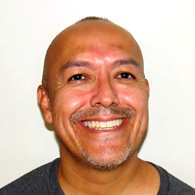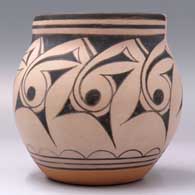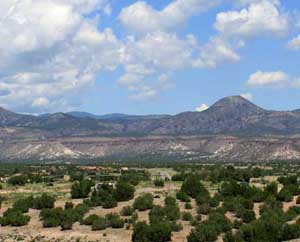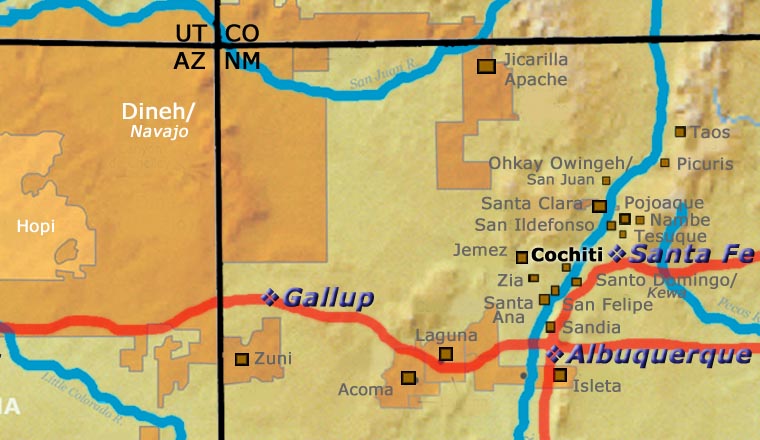
Jeff Suina
Cochiti

Born in 1972, Jeff Suina is a potter from Cochiti Pueblo. The son of Joseph Henry and Margaret Lorraine Suina, he didn't grow up in the usual pottery making household, although he was surrounded by relatives who did make pottery. His mother made a few storytellers and polychrome jars and bowls over the years but his father was an educator, prominent in the changing of Native American education (as administered by government forces) so that it better fit Native Americans and their cultures. Joseph was a professor at UNM for about 25 years, then he was involved in tribal politics for another couple decades.
Jeff grew up in a home full of opportunity of all sorts. When we asked him what he might like the world to know about him, other than that he's a potter, he responded that he's a sci-fi nerd who enjoys flying drones and he loves heavy metal music.
Jeff says he learned the basics of how to make pottery from his mother but he had some help from Virgil Ortiz with learning how to prepare his materials. Like many potters, Jeff didn't really put his hands in clay until he was in his 30s. Then Clay Mother took hold of his life.
His favorite shapes to make are asymetrical. His favorite designs include stars and other astronomical objects as he says he gets inspiration from astronomy and from quantum mechanics, physics, current events and the world of plants.
Jeff has participated in the Santa Fe Indian Market and the Bernalillo Arts Festival, where he won a Best in Show award for an asymetrical geometric piece.
Update 2024. At the 2024 Santa Fe Indian Market, in Classification IIE: Category 901 - Slabwork, Jeff won First Place. He also won the Second Place ribbon in Classification IIE: Category 906 - Sgraffito and Carved, any form.
100 West San Francisco Street, Santa Fe, New Mexico 87501
(505) 986-1234 - www.andreafisherpottery.com - All Rights Reserved

Cochiti Pueblo

View west across Cochiti Pueblo
Cochiti Pueblo lies fifteen miles south of Santa Fe along the west bank of the Rio Grande. Frijoles Canyon in what is now Bandelier National Monument is the site of the pueblo's most recent ancestral home. The Eastern Keresans may have relocated to the Bandelier area from the Four Corners region around 1300.
Cochiti legend says that Clay Old Woman and Clay Old Man came to visit the Cochitis. While all the people watched, Clay Old Woman shaped a pot. Clay Old Man danced too close and kicked the pot. He rolled the clay from the broken pot into a ball, gave a piece to all the women in the village and told them never to forget to make pottery.

At Bandelier National Monument
In prehistoric times, human effigy pots, animals, duck canteens and bird shaped pitchers with beaks as spouts were common productions of the Cochiti potters. Many of these were condemned as idols and destroyed by the Franciscan priests. That problem stopped when the Spanish left in 1820 but the fantastic array of figurines created by Cochiti potters was essentially dormant until the railroad arrived. Then Cochiti potters were among the first to enter the tourist market and they produced many whimsical figures into the early 1900s. Then production followed the market into more conventional shapes.
Legend has it that a Ringling Brothers Circus train broke down near Cochiti Pueblo in the 1920s. Supposedly, the tribe's contact with the ringmaster, trapeze artists, opera singers, sideshow quot;freaks" and exotic animals paved the way for a variety of new figural subjects. However, shortly after the railroad passed through, a delegation of Cochiti men got on the train and traveled to Washington DC. There they were introduced to the President, spoke to Congress, and were taken on a tour of the "highlights" of American civilization in Washington and in New York City, incuding the Metropolitan Opera, the Bronx Zoo and a performance of the Ringling Brothers Circus. As none of the men could read or write, nor draw, what they brought back to Cochiti was what they remembered of things they had never seen before. The stories they told must have been wild. An astute observer will find angels, nativities, cowboys, tourist caricatures, snakes, dinosaurs, turtles, goats, two-headed opera singers, clowns, tattooed strongmen, Moorish nuns and even mermaids in the Cochiti pottery pantheon, many produced only since the early 1960s and based on characters described in Cochiti's oral history.
A few modern potters make traditional styled pots with black and red flowers, animals, clouds, lightning and geometric designs but most Cochiti pottery artists now create figurines. Most notable is the storyteller, a grandfather or grandmother figure with "babies" perched on it. Helen Cordero is credited with creating the first storyteller in 1964 to honor her grandfather. The storyteller style was quickly picked up by other pueblos and each modified the form to match their local situation (ie: clay colors and tribal and religious traditions). In some pueblos, storytellers are also now made as drummers and as a large variety of animals.
Today, Cochiti potters face the challenge of acquiring the clay for the white slip. Construction of Cochiti Dam in the 1960s destroyed their primary source of their trademark white slip and gray clay. Now the white slip comes from one dwindling source at Santo Domingo, Cochiti Pueblo's neighbor to the south.
Most outsiders who visit Cochiti Pueblo these days do so on the way to or from either the recreation area on Cochiti Lake or Kasha-Katuwe Tent Rocks National Monument.
100 West San Francisco Street, Santa Fe, New Mexico 87501
(505) 986-1234 - www.andreafisherpottery.com - All Rights Reserved
